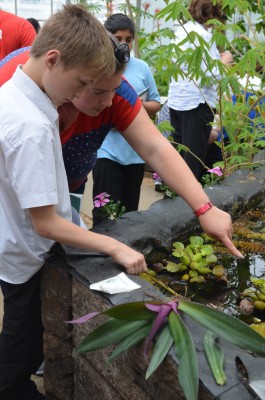
What’s in the water? Plants that keep it clean and clear.
Today pupils from Ranikhet Primary School visited the Tropical Biodiversity Greenhouse (Part of Reading University Herbarium in the School of Biological Sciences) to see, smell, touch and draw plants that grow in the tropics, and particularly the tropical rainforest.
Two classes visited to hear about the features of rainforest plants: leaves that shed excess water and often have drip-tips; adaptations to too much light, too little light, poor soil, strong winds, plants growing on other plants, things to eat and things to avoid.
We looked at members of the pineapple family, known to botanists as bromeliads, including a pineapple in fruit, a range of bromeliads growing on an artificial tree branch and even Spanish Moss, a plant that hangs from twigs and even from power lines in the Americas.
We talked about where tropical rainforests are found – South America (The Amazon), Africa and Asia. Did you know that plants capture over 100 billion tonnes of carbon from the atmosphere each year, that’s the weight of 18 blue whales per second!

Wet tropical forests of the world (thank you Wikimedia commons CC0)
After some questions and answers the pupils had the opportunity to draw the plants. Here is a gallery of their tropical investigations.

Sugar cane leaves have sharp teeth along the edges. You can run your finger along the edge from the base to the tip of the leaf but not the other way!

Not many traps left to close. Do they eat fingers? Luckily not!

What do these plants do? Many eat animals – plant food delivered to your leaf.

The carnivorous plants in the low nutrient area were very popular

Careful artwork in progress – the star fruit was a star attraction.

Venus flytraps – are NOT from tropical forests, they grow in temperate North America.

Chilli peppers offer risk, excitement and bright colours. But take care, the juice can burn your lips and eyes.

Leaves have to shed rainwater or the plant could drown.

I explain that Spanish moss really is a plnt – it has stems, leaves and is green underneath the grey surface hairs.

Taking care with the sugar cane leaf.

These plants can float – how do they do it?

Sir, these roots are longer than I am!
Ranikhet have their own School Blog, do have a look.

The pupils were glad to get back into the cool after cooking in the greenhouse.
About Alastair Culham
A professional botanist and biologist with an interest in promoting biological knowledge and awareness to all.















